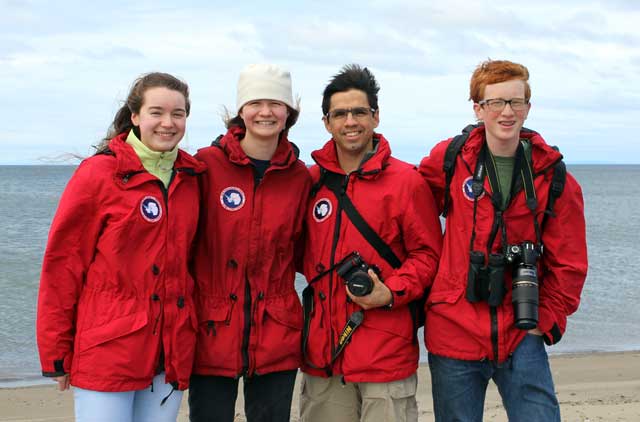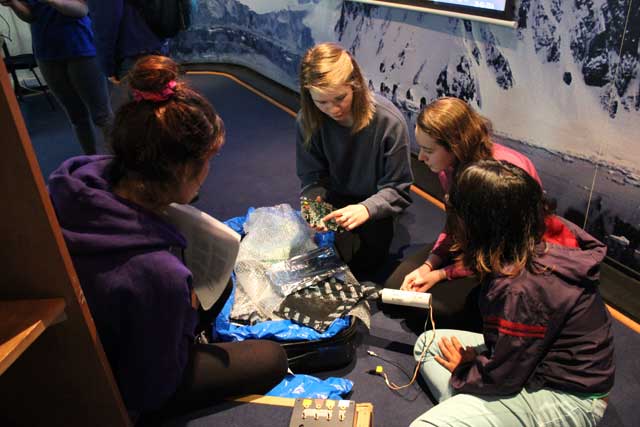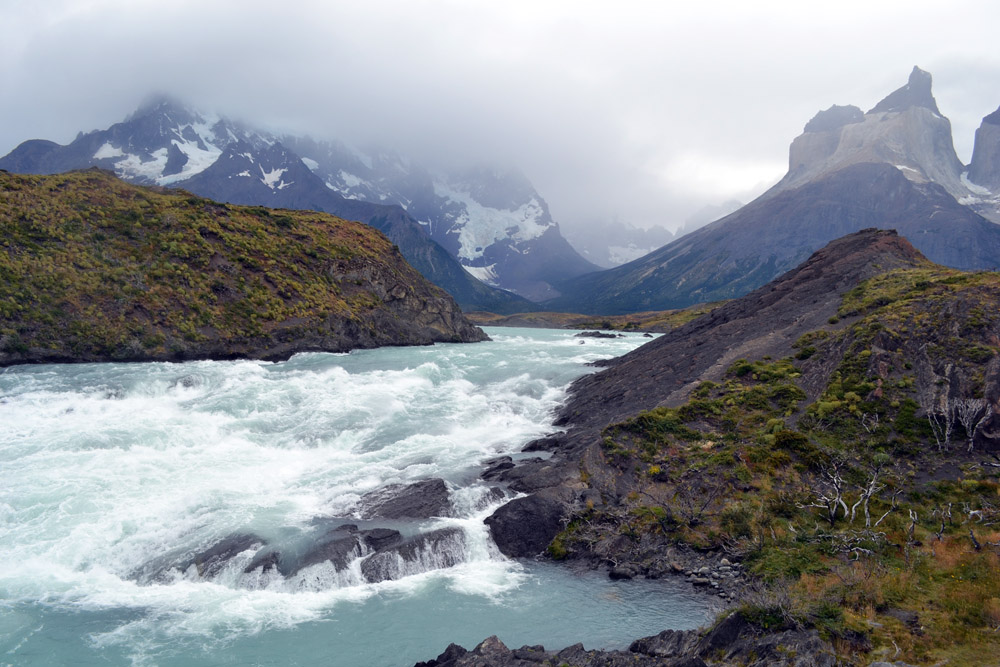|
Exchange programU.S. students travel to Chile to learn about science in AntarcticaPosted May 30, 2014
The Joint Antarctic School Expedition (JASE) This pilot program aimed to provide participants with hands-on experience with Antarctic environments and ecosystems research. For 10 years, the Instituto Antártico Chileno (INACH) In 2013, INACH invited the United States to participate in the Antarctic School Expedition. The National Science Foundation’s Division of Polar Programs 
Photo Credit: Lynn Reed
Anna Caldwell-Overdier, Claire Hacker, Juan Botella, and Luke Maillefer, from left, proudly wearing USAP jackets on the beach in Punta Arenas, Chile. The Monona Grove High School students and their teacher participated in the pilot Joint Antarctic School Expedition.
Working through the Arctic Research Consortium of the United States (ARCUS) Next, three students from his school were chosen to participate from a pool of competitive applicants: Anna Caldwell-Overdier, Claire Hacker, and Luke Maillefer. Both Caldwell-Overdier and Maillefer are 11th graders; Hacker is a senior and will be attending Cornell University in the fall. In addition, as the Einstein Educator Fellow The U.S. team joined 11 students and five teachers from Chile on Feb. 16 in Punta Arenas, an Antarctic gateway city and location of INACH headquarters. The five winning Chilean teams gave presentations about their own research, as well as about their schools and regions of Chile. The U.S. team gave a presentation on the IceCube Neutrino Observatory “One of the most memorable experiences from my time in Punta Arenas is the afternoon we spent at the INACH laboratory,” Hacker says. “Our visit began with a short tour and then we proceeded to try out some lab techniques ourselves.” The students divided into groups to learn about different ways to detect specific proteins. They focused on proteins called cryoproteins, which are responsible for keeping some Antarctic plants from freezing. 
Photo Credit: Lynn Reed
U.S. students Claire Hacker and Anna Caldwell-Overdier demonstrate cosmic-ray detector equipment to a couple of the Chilean students.
“Because I knew very little about this subject, and because I was learning about the new procedures in Spanish, my experience in the lab was exciting yet challenging in a lot of ways,” Hacker says. “I hope some of the knowledge I gained finds its way into my future career, because I will never forget learning about microbiology in a laboratory in Chile.” After the initial seminars and presentations, the program was to move to King George Island, with JASE participants staying at INACH’s Escudero station and visiting other countries’ stations. The students were to be given the opportunity to work with Antarctic scientists in the field and learn about subjects ranging from glaciology to ecology. Unfortunately, the Antarctic deployment was not completed as planned due to an outbreak on the second day in Punta Arenas of a gastrointestinal illness that affected about a third of the group. To prevent carrying the “bug” to the Antarctic stations, INACH made the difficult decision to cancel the trip. Although disappointed, all the teachers and students understood and supported the decision. “We were all looking forward to doing research in Antarctica. I wanted to learn more about the research that Dr. Mauricio Rondanelli from Universidad de Concepción is conducting using pollen,” Botella says. “We were to learn about the techniques used for identifying pollen that arrives from South America to King George Island,” he explains. “This study might become even more important as climate change modifies the environmental conditions of the islands to the point that new plant species are able to establish there.” Botella says he was also eager to collect the vascular plants that grow on King George Island to study the cyroproteins that protect them from the cold. “Nevertheless, I came out from this experience inspired to help my students engage in fairly complex scientific projects after seeing how Chilean teachers with fewer resources are able to guide their students,” he says. “I was very impressed by the complexity of the Chilean student projects and their willingness to share their work.” While the students were unable to go to Antarctica, INACH helped arrange alternate natural-science experiences for the U.S. group, including a trip to Torres del Paine National Park “The centerpiece of the park is three massive granite towers jutting up from the ground at impossible angles,” Maillefer recalls. “It was amazing to learn how millions of years ago sedimentary layers of the earth accumulated and solidified and after years and years of glacial erosion only the resilient granite peaks remained.” On another day, the students took a two-hour boat ride to Isla Magdalena, which is home to about 60,000 pairs of Magellanic penguins. “To see penguins burrowing, swimming, and waddling, not in a zoo, but in their natural habitat, was amazing,” Maillefer says. The Chilean students will go to Escudero Station later in the year, perhaps during the winter holidays. After leaving Punta Arenas, the U.S. team traveled to Santiago for a couple of presentations, including to an eighth-grade class and at the U.S. embassy. The JASE team kept an online journal (in both English and Spanish) where they related their experiences and shared photographs. The journals and the webinar that the team held on Feb. 25 may be found on the PolarTREC website at www.polartrec.com/expeditions/joint-antarctic-school-expedition-2014 |



For USAP Participants |
For The Public |
For Researchers and EducatorsContact UsNational Science FoundationOffice of Polar Programs Geosciences Directorate 2415 Eisenhower Avenue, Suite W7100 Alexandria, VA 22314 Sign up for the NSF Office of Polar Programs newsletter and events. Feedback Form |



